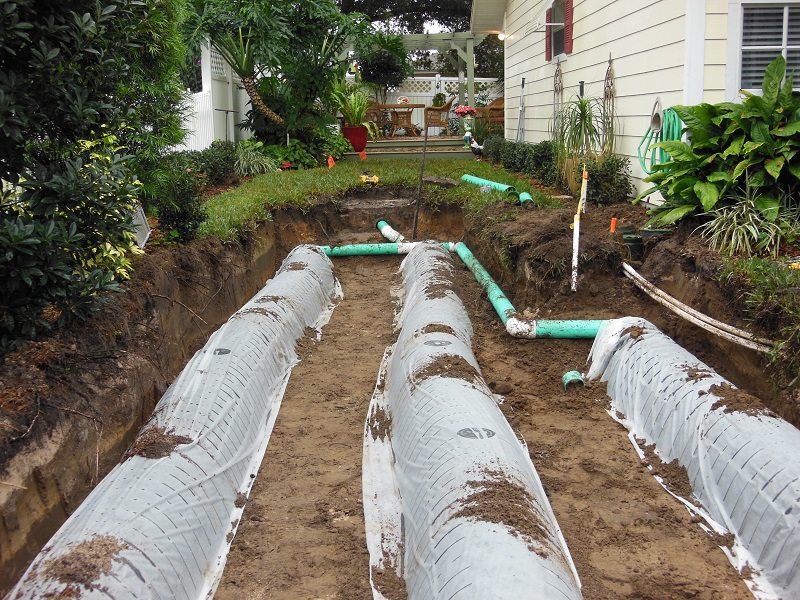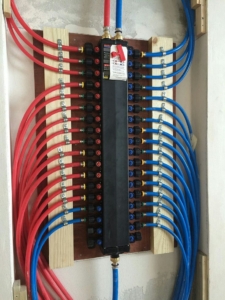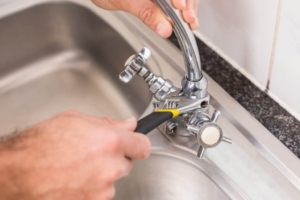Understanding the Importance and
Maintenance of Septic Drain Fields
A septic drain field is a primary component of any septic system. It plays a role in the proper functioning and disposal of wastewater from your home or business. This underground area, also known as a leach field or absorption field, is responsible for filtering and dispersing the liquid waste that exits your septic tank. By allowing the wastewater to seep into the soil gradually, the drain field helps to remove harmful bacteria, viruses, and other contaminants before they can reach the groundwater. In this blog post, we will explore the importance of a well-maintained septic drain field and provide you with some essential tips to keep it in optimal condition.
What is a Septic Drain Field?
The Purpose of a Septic Drain Field
The primary function of a septic drain field is to distribute and filter the effluent (liquid waste) from the septic tank into the soil. This allows for the natural breakdown of harmful bacteria, viruses, and other contaminants present in the wastewater. The drain field helps to ensure that the treated effluent is safely absorbed into the ground, preventing any potential harm to the environment and public health.
How a Septic Drain Field Works
A septic drain field consists of a network of perforated pipes, also known as leach lines or lateral lines, that are buried underground. These pipes are typically laid out in gravel-filled trenches, which serves as a medium for the effluent to percolate through. The gravel provides additional surface area for the effluent to be treated as it comes into contact with the soil.
Once the wastewater flows out of the septic tank, it enters the drain field through a distribution box or a distribution pipe. From there, it disperses evenly into the leach lines and gradually filters into the surrounding soil. The soil acts as a natural filter, removing any remaining impurities from the effluent before reaching groundwater.
Importance of Proper Drain Field Maintenance
Maintaining a healthy and functional septic drain field is crucial for the overall performance of a septic system. Regular maintenance, such as pumping the septic tank, avoiding excessive water usage, and being mindful of what goes down the drains, can help prevent issues like clogging, wastewater backups, and premature drain field failure.
It’s essential to keep the drain field area free from heavy vehicles, construction activities, and excessive water runoff, as these can compact the soil and disrupt the natural filtration process. Proper landscaping and vegetation management around the drain field can also help maintain its effectiveness.
Importance of a Septic Drain Field
Function of a Septic Drain Field
The primary function of a septic drain field is to disperse and treat wastewater that has been filtered and partially treated by the septic tank. This field consists of a network of perforated pipes buried underground, allowing the wastewater, known as effluent, to seep into the surrounding soil.
Through a natural biological process, the effluent undergoes further filtration and treatment as it percolates through the soil layers. The soil acts as a natural filter, removing harmful bacteria, viruses, and other contaminants from the wastewater. This process helps to prevent the contamination of groundwater and nearby water bodies.
Role in the Septic System
The septic drain field plays a crucial role in the overall functioning of a septic system. Once the solid waste settles and undergoes anaerobic digestion in the septic tank, the liquid effluent flows into the drain field. This is the final stage of the treatment process before the wastewater returns to the environment.
By evenly distributing the effluent over a large area, the drain field prevents overloading of any single section of the soil. It allows for the gradual absorption and treatment of the effluent, preventing any potential health hazards or pollution issues.
Environmental Impact
The proper functioning of a septic drain field has a positive environmental impact, contributing to the protection of water resources and ecosystems. When the effluent is adequately treated by the drain field, it significantly reduces the risk of groundwater contamination.
Groundwater serves as a source of drinking water for many households and communities. If the septic drain field is not functioning correctly or is poorly maintained, untreated contaminants may infiltrate the groundwater, posing a threat to public health and the environment.
The drain field also plays a role in preventing the pollution of surface water bodies such as lakes, rivers, and streams. The natural filtration process carried out by the soil helps remove pollutants from the effluent before it reaches these water sources.
Signs of Septic Drain Field Problems
Slow Draining Fixtures
One of the first signs that there may be an issue with your septic drain field is the presence of slow draining fixtures. This can include sinks, toilets, showers, and other drains in your home. If you notice that water is taking longer than usual to drain, it could be an indication of a blockage or backup in your drain field.
To address this problem, you can start by using a plunger to try and unclog the fixture. If that doesn’t work, it may be necessary to call a professional septic service provider to inspect and address the issue. Remember, it’s important to resolve slow draining fixtures promptly to prevent further damage to your drain field.
Foul Odor
Another telltale sign of septic drain field problems is a foul odor emanating from your property. If you detect a strong, persistent smell of sewage or rotten eggs near your drain field, it’s a clear indication that something is amiss.
The foul odor can be caused by a variety of issues, including a clogged drain field, a cracked septic tank, or a malfunctioning sewage pump. It’s crucial not to ignore this sign, as it may signify a significant problem that requires immediate attention. Contacting a professional septic technician to diagnose and resolve the issue is highly recommended.
Standing Water
The presence of standing water in your yard, particularly around the drain field area, is another red flag indicating septic drain field problems. This could be a result of a blocked or saturated drain field, preventing proper drainage of wastewater.
If you notice soggy or marshy patches of land, pooling water, or excessive vegetation growth in the drain field area, it’s crucial to address the issue promptly. Standing water can lead to sewage backup, contamination of groundwater, and potential health hazards. Contact a septic professional to assess the situation and provide appropriate solutions.
Causes of Septic Drain Field Issues
Excessive Water Usage
One of the primary culprits behind septic drain field problems is excessive water usage. When a household consumes an excessive amount of water, it puts a strain on the septic system, including the drain field. This overload can lead to the field becoming oversaturated, causing the soil to become compacted and reducing its ability to effectively absorb and treat wastewater.
To prevent excessive water usage, it is essential to be mindful of water consumption habits. Simple measures such as fixing leaky faucets, using water-saving appliances, and spreading out laundry and dishwashing loads can significantly reduce the strain on the septic system and help maintain a healthy drain field.
Solid Waste Buildup
Another significant cause of septic drain field issues is the accumulation of solid waste within the septic tank. Over time, solid waste can build up, forming a layer of sludge at the bottom of the tank. If this sludge is not regularly pumped out, it can flow into the drain field and clog the soil and pipes.
Regular septic tank pumping is needed to prevent solid waste buildup and protect the drain field. It is recommended to have the tank pumped every 3-5 years, depending on the household size and water usage. Practicing proper septic system maintenance, such as avoiding flushing non-biodegradable items down the toilet, can help prevent solid waste accumulation and extend the life of the drain field.
Tree Root Intrusion
Tree root intrusion is a less commonly known but equally damaging cause of septic drain field issues. As trees grow, their roots can extend into drain field pipes, causing blockages and damage. The roots are attracted to the water and nutrients present in the drain field, making it an ideal environment for them to thrive.
To prevent tree root intrusion, it is advisable to plant trees at a safe distance from the septic system. Understanding the type of trees and their root systems can also help homeowners make informed decisions about landscaping near the drain field. If tree roots have already infiltrated the drain field, professional assistance may be required to remove the roots and repair any damage caused.
Maintaining a Septic Drain Field
Regular Pumping
Regular pumping is vital to keep your septic drain field in optimal condition. Over time, solid waste and sludge accumulate in the septic tank, which can clog the drain field if not removed. It is recommended to have your septic tank pumped every three to five years, depending on its size and household usage.
By scheduling regular pumping, you prevent solids from entering the drain field, ensuring its longevity. Hiring a professional septic tank service to perform the pumping will ensure a thorough and proper job.
Avoiding Harsh Chemicals
Using harsh chemicals in your household can harm the helpful bacteria in your septic tank that break down waste. These chemicals include harsh drain cleaners, strong solvents, and antibacterial soaps. When these substances reach the septic system, they can disrupt the balance of bacteria, leading to a less efficient breakdown of waste.
To maintain a healthy septic drain field, opt for environmentally friendly and septic-safe cleaning products. Choose phosphate-free detergents mild soaps, and avoid pouring chemicals down the drain that can harm the septic system.
Proper Waste Disposal
Proper waste disposal plays a significant role in maintaining the health of your septic drain field. Avoid flushing or draining non-biodegradable materials such as wipes, feminine hygiene products, diapers, cigarette butts, and cooking oils. These items can clog the drain field and cause significant damage to the septic system.
Be mindful of the water usage in your household. Excessive water consumption can overload the septic system and hinder its ability to treat the waste properly. Repair any leaks promptly and practice water-saving habits like installing low-flow fixtures and being mindful of water usage habits.
References:
Repairing a Failing Septic Drain Field
When it comes to a failing septic drain field, there are a couple of options for repair: Drain Field Rejuvenation and Drain Field Replacement.
Drain Field Rejuvenation
Drain field rejuvenation is a process that aims to restore the functionality of a failing septic drain field. This method is often preferred if the drain field is not severely damaged and can still be salvaged.
The rejuvenation process involves several steps. First, the drain field is inspected to assess the extent of the damage and identify any potential issues. Next, any clogs or blockages within the drain field pipes or distribution box are cleared to promote better wastewater flow.
After clearing the blockages, the next step is to introduce beneficial bacteria into the drain field. These bacteria help break down organic matter and restore the balance of microorganisms in the soil around the drain field. This process can enhance drainage and increase the absorption capacity of the drain field.
Drain Field Replacement
In cases where a drain field is extensively damaged or rejuvenation efforts have failed, drain field replacement becomes necessary. This process involves the complete removal and replacement of the existing drain field with a new one.
Before replacing the drain field, a thorough evaluation of the soil conditions and site suitability is conducted. The new drain field is designed and installed based on the specific requirements of the property, ensuring proper wastewater treatment and absorption.
The replacement process typically begins with excavating the old drain field and removing any debris or failed components. Then, a new distribution box, perforated pipes, and gravel or stone are installed in the designated area. The pipes are surrounded by a layer of filter fabric to prevent soil intrusion and maintain the longevity of the drain field.
Once the installation is complete, the drain field is thoroughly tested to ensure proper functioning and compliance with local regulations. Regular maintenance and monitoring of the drain field are essential to prevent future issues and extend its lifespan.
Conclusion
In conclusion, maintaining a healthy septic drain field is crucial for the overall functionality and longevity of your septic system. Regular inspection and maintenance, along with implementing proper usage habits, can significantly extend the lifespan of your drain field. By avoiding excessive water usage, disposing of waste appropriately, and avoiding the use of harmful chemicals, you can keep your drain field in optimal condition for years to come. Remember, a well-maintained drain field is the key to a well-functioning septic system, ensuring the efficient treatment and disposal of household sewage.







